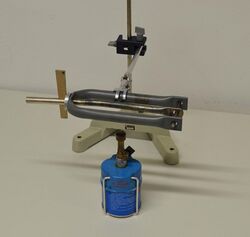Physics:Tyndall's bar breaker
Tyndall's bar breaker is a physical demonstration experiment to demonstrate the forces created by thermal expansion and shrinkage. It was demonstrated 1867 by the Irish scientist John Tyndall in his Christmas lectures for a "juvenile auditory".[1][2]
Setup
The bar breaker experiment comprises a very rigid frame (d) and a massive connecting rod (b). The rod is held on one side by a cast iron bar (c) that is going to be broken in the experiment and, at the other end, by a nut (a) that is used to compensate the thermal expansion.[3]
Procedure
During the experiment the steel rod (b) is heated with a flame (e) up to red heat temperature. During the heating phase the thermal expansion of the rod (b) is compensated by tightly fastening the nut (a). Taking away the flame starts the cooling phase. Typically the bar (c) breaks within a few minutes with a loud bang or it is at least deformed significantly. File:Tyndalls's bar breaker experiment.mpg
References
- ↑ John Tyndall (1867) (in French), Chaleur et Froid: Six leçons faites devant un jeune auditoire pendant les vacances de noel 1867, Paris, p. 28, https://archive.org/details/chaleuretfroids00tyndgoog/page/n37/mode/1up, retrieved 2020-09-08
- ↑ "On Heat and Cold: A Course of Six Lectures (Adapted to a Juvenile Auditory) (Christmas 1867)", The Chemical News XVII (423): p. 15, 1868, https://books.google.com/books?id=XYc5MzR6PY8C&q=tyndall+steel+bar+snapped&pg=PA16, retrieved 2020-09-08
- ↑ Manual for Tyndall's bar breaker experiment (PDF)
Media
 |



